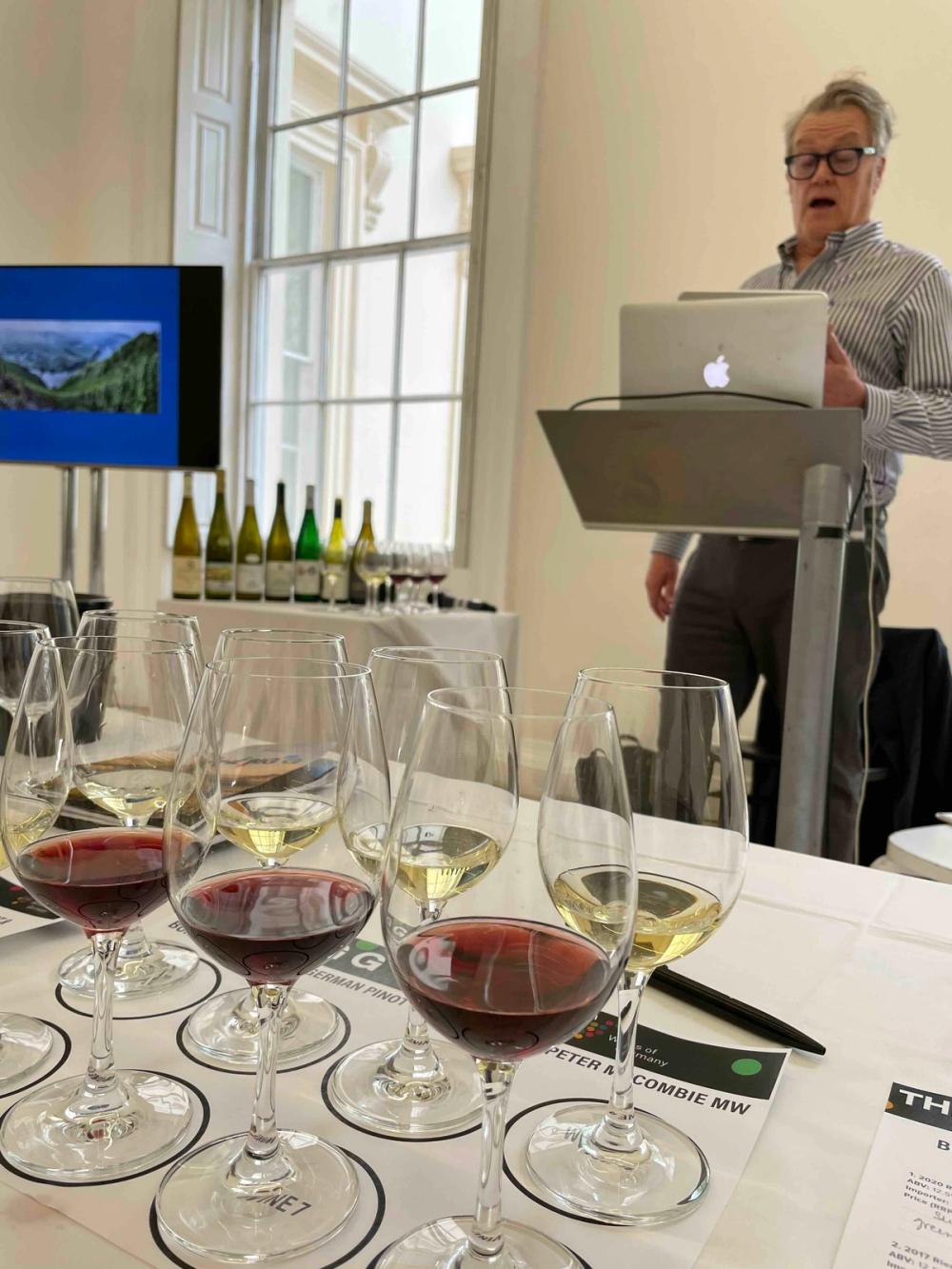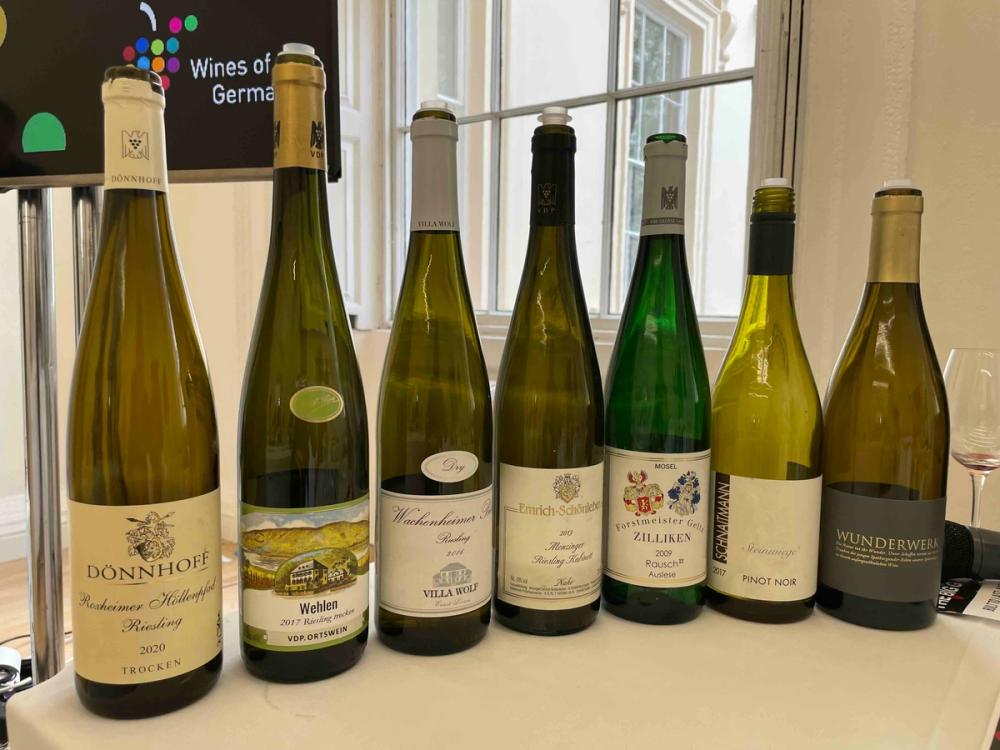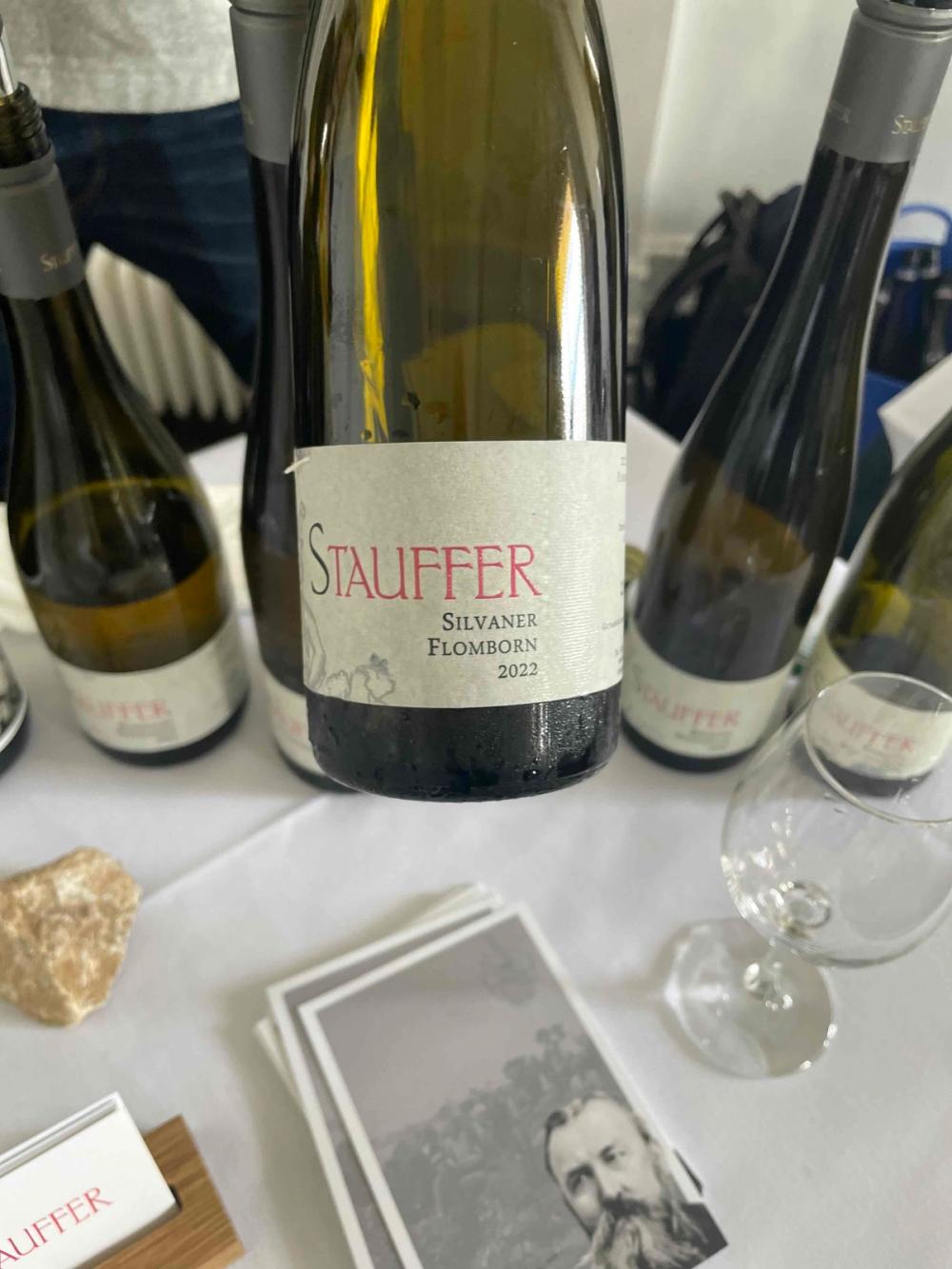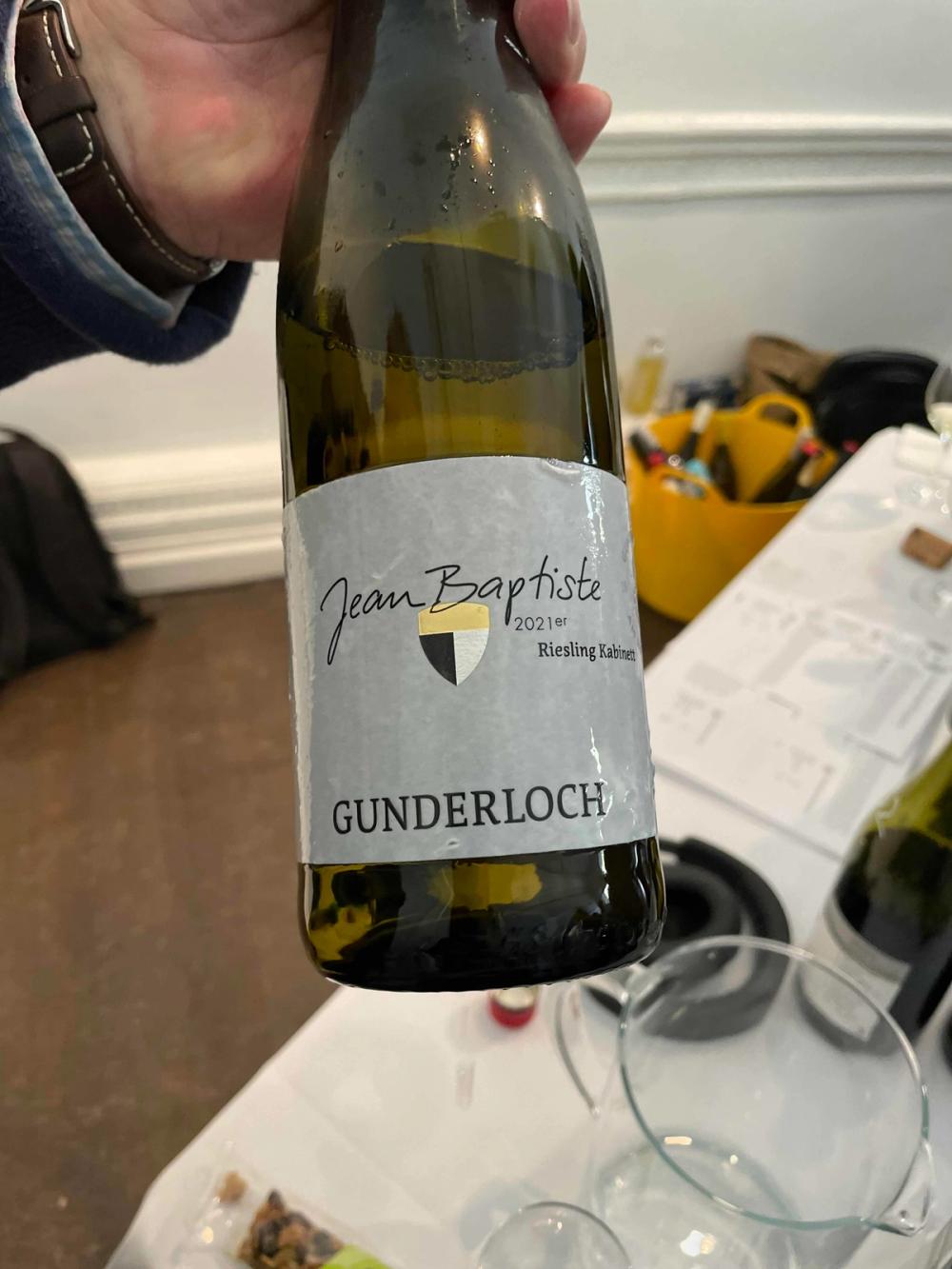Diversity and versatility were the themes at the recent Wines of Germany Big G tasting in London. There was a focus on lighter styles of Riesling, Spätburgunder and Sekt and a masterclass hosted by Peter McCombie MW explored the age-ability of Riesling and Spätburgunder (Pinot Noir). Half a dozen wine importers were on hand together with about 20 individual wineries, some looking for representation in the UK, offering much to explore and consider.
The event reiterated that German wine remains a ‘wine for all reasons’.

Peter McCombie MW looked at lighter styles of Riesling and Spätburgunder
Germany offers the UK trade an interesting proposition. In the retail market there is an emerging trend toward ‘premiumisation’ of retail customers, spending more but less often. In addition, the trade market is always looking for that wine which will be a differentiator as well as good value.
Germany, with its multiple options beyond Riesling is a perfect place to find both.
Overlooking the vast array of Germany’s varietals beyond Riesling would be a mistake for wine lovers and wine sellers alike. Germany offers an array of options with over 100,000 hectares planted, two thirds to white varieties and an impressive diversity in soils across the regions, matched only by a diversity in topography – punctuated with mountain ranges, bodies of water and more moderate temperatures.
In Germany Riesling is King. It is without doubt, the mainstay and most celebrated grape in Germany’s arsenal and, with 24,000 hectares, it puts Germany ahead of France and Australia in Riesling plantings. Grown in all 13 of Germany’s wine regions, it is understandable why Riesling is synonymous with German winemaking. And yet, as McCombie commented in his masterclass, “Riesling is famously the wine that people in the wine trade like to drink but find difficult to sell.”

The wines chosen for the masterclass
The Classics - built to last
The masterclass provided great insights regarding aged Rieslings. Rieslings with a few years of age (i.e. 2020), through to 2009 found a consensus from the audience that with some age Riesling had a greater adaptability to food.
For example, the 2017 Riesling Wehlen Trocken from S.A. Prüm in Mosel (retail £32.99), with 6.6g of residual sugar, displayed a very textural, very honeyed, weightier mouthfeel. It was subtle yet with power that could handle stronger flavours. McCombie suggested, despite their perceived delicacy, there is scope for these wines to be used more boldly in matching combinations. In fact, the lovely play between the sweetness and acidity created an excellent opportunity to be bold and play with flavours.McCombie suggested a Pissaladière with the Prüm while other combinations could include Thai food with its sweet, sharp, lime and tamarind flavours.
The Villa Wolf 2016 Wachenheim Belz, from the Pfalz retailing at £16.99, from one of the sunniest and warmest of the German regions (with a climate akin to Alsace), exhibits less austerity when compared to the Mosel and riper stone fruit rather than green. The wines are dry, fuller bodied with fully ripe fruit flavours. The wine had finesse but a slightly less delicate nature than the other Rieslings – there was a robustness to it, ample without being heavy. Fleshy, the wine integrates and comes together, without the searing acidity of younger Rieslings. More appley notes offering a happy accompaniment to pork or meatier fish.
For what is regarded as a cool climate, there was diversity in the style of the aged Pinot Noir at the tasting – some more generous, while others more austere – but all of which had freshness and character. The 2017 Spätburgunder Wunderwerk from Dreissigacker in the Rheinhessen retailing at £65.99, offered a wine of complexity and charm with generous fruitiness and fine tannins; not as taut but a more generous style – a lovely bedfellow for venison. Likewise, and at half the price at £29.99 retail, was the 2017 Steinwieger Schnaitmann Pinot Noir from Württemberg. This lovely wine showed savoury, dried herbal notes and a palate of moreish chewy tannins, that could be a great accompaniment to ox tongue and other meaty dishes.
Two notables seeking representation
What was striking was the number of producers making wine from other varieties, in particular Chardonnay and Sauvignon Blanc. While the trade has tended to turn towards indigenous varieties, these examples of noble grapes show a class and confidence of the Old World. For me, the Sauvignon Blancs in particular, showed great promise and interest. The latter had some fumé style which were characterful and expressive.

Of the wines looking for UK representation, two stood out - the wines from Weingut Stauffer from Rheinhessen with limestone soils and high elevation, and vines over 50 years old. Carolin Stauffer noted that being a less ‘classical’ region, there is more flexibility, more open-mindedness and many varieties grown. Its Silvaner, a grape with lower acidity, and aged in 1300-litre old barrels, with green notes, spicy and linear palate was moreish and fine skinsy notes. So too, its reserve Sauvignon Blanc was rich, textural and powerful with fine powdery acidity. The Auxerrois was supple, delicate with lime and green melon with lots of potential for ageability.
Weingut Burg Ravensburg’s Bläufrankisch 2018 from Baden was spicy, concentrated, rich and pure. Grown on limestone and mineral-rich soils, the wine was lifted, complex and layered.
Other wines that stood out
Many of the producers’ listings tend to be price-driven, and stylistically lean towards Rieslings that are easy drinking, fresh and dry. However, they all had other cuvées which offer additional listing opportunities. Naturally across all the portfolios there were a strong selection of Rieslings and Pinot Noirs.

Gunderloch, from Rheinhessen, their 2021 Riesling Pettenthal Grosses Gewächs, shows serious elegance, depth and precision. Bone dry, lemon, lime and citrus pith. (Awin Barratt Siegel)
Mosel’s S.A. Prüm 2021 Riesling, Blue with a residual of 5.5g and retail of £20.50 – shows classic purity, length and precision. (Delibo)
Wittmann Aulerde Riesling GG 2020 – from the warmest of the sites this has precision, power, good length and purity. At £41.67 this sits in a different league. In contrast, at close to a third the price, its 2020 Silvaner Riesling Natural with skin contact had exuberance and energy. (OW Loeb)
Wines that showed German wine’s diversity
As noted earlier though there were several ‘outliers’ that show the diversity of German wines and an excellent opportunity to differentiate a wine list.

From Pfalz, Oliver Zeter Sauvignon Blanc Fumé – retailing at £27; has classic fumé characteristics – exuberant gooseberry nose, very pure and elegant with subtle smoky nuances. (Delibo)
From the Rheingau, Corvers-Kauter Secco Rosé 2022 has tremendous appeal.Retailing at £22, the wine is made with the tank method using Cabernet Sauvignon and Pinot Noir, with 15g dosage and offering flavours of blackberry pie. This could offer a great alternative on a sparkling list. (Graft)
Emil Bäuer Scheu…Aber Geil! Pfalz – made from Scheurebe, this is elegant, zesty and delicate. Lemon pith and grapefruit. (Graft)
Schatzel Naturweiss – fresh, mineral, clean grapefruit, very dry, forward on the palate – a blend of Riesling, Sylvaner, Muller Thurgau and Pinot Blanc, made on the skins for two weeks, unfined, unfiltered and no added sulphur. £26 (Top Selection)
Nik Weis Pinot Noir 2019 – from Mosel, 18 months old barrique, 6 months in bottle, soft, supple, very minerally, textural, more austere style needs food. Retailing at £27 (Top Selection)
The Big G shows that Germany offers ‘wines for all reasons’. Further, in what might be considered a mature market, the up-and-coming styles, expansion to other varieties, and their more moderate climate, reaffirms that Germany needs our attention.
































